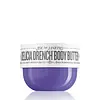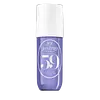What's inside
What's inside
 Key Ingredients
Key Ingredients

No key ingredients
 Benefits
Benefits

No benefits
 Concerns
Concerns

 Ingredients Side-by-side
Ingredients Side-by-side

Water
Skin ConditioningButyrospermum Parkii Butter
Skin ConditioningCocos Nucifera Oil
MaskingEthylhexyl Palmitate
EmollientParfum
MaskingMethyl Glucose Sesquistearate
EmollientGlyceryl Stearate Se
EmulsifyingLauryl Laurate
Skin ConditioningGlycerin
HumectantMyristyl Myristate
EmollientHydrolyzed Sodium Hyaluronate
Skin ConditioningLactobacillus/Hibiscus Sabdariffa Flower Ferment Filtrate
Skin ConditioningCopaifera Officinalis Resin
MaskingPassiflora Edulis Seed Oil
EmollientPlatonia Insignis Seed Butter
EmollientTheobroma Grandiflorum Seed Butter
Skin ConditioningSqualane
EmollientTocopherol
AntioxidantBixa Orellana Seed Extract
MaskingCetearyl Alcohol
EmollientBehenyl Alcohol
EmollientCaprylic/Capric Triglyceride
MaskingPhenyl Trimethicone
Skin ConditioningMaltodextrin
AbsorbentCetearyl Olivate
Sorbitan Olivate
EmulsifyingSodium Stearoyl Glutamate
CleansingPotassium Cetyl Phosphate
EmulsifyingSodium Gluconate
Skin ConditioningEthylhexylglycerin
Skin ConditioningPhenoxyethanol
PreservativeButylene Glycol
HumectantCarbomer
Emulsion StabilisingPotassium Hydroxide
BufferingSodium Hydroxide
BufferingCI 75120
Cosmetic ColorantAlpha-Isomethyl Ionone
PerfumingWater, Butyrospermum Parkii Butter, Cocos Nucifera Oil, Ethylhexyl Palmitate, Parfum, Methyl Glucose Sesquistearate, Glyceryl Stearate Se, Lauryl Laurate, Glycerin, Myristyl Myristate, Hydrolyzed Sodium Hyaluronate, Lactobacillus/Hibiscus Sabdariffa Flower Ferment Filtrate, Copaifera Officinalis Resin, Passiflora Edulis Seed Oil, Platonia Insignis Seed Butter, Theobroma Grandiflorum Seed Butter, Squalane, Tocopherol, Bixa Orellana Seed Extract, Cetearyl Alcohol, Behenyl Alcohol, Caprylic/Capric Triglyceride, Phenyl Trimethicone, Maltodextrin, Cetearyl Olivate, Sorbitan Olivate, Sodium Stearoyl Glutamate, Potassium Cetyl Phosphate, Sodium Gluconate, Ethylhexylglycerin, Phenoxyethanol, Butylene Glycol, Carbomer, Potassium Hydroxide, Sodium Hydroxide, CI 75120, Alpha-Isomethyl Ionone
 Reviews
Reviews

Alternatives
Ingredients Explained
These ingredients are found in both products.
Ingredients higher up in an ingredient list are typically present in a larger amount.
Alpha-Isomethyl Ionone is a fragrance. It can be synthetically created or naturally occurring.
The scent of Alpha-Isomethyl Ionone is described as "flowery" but can also be "woody".
Naturally occurring Alpha-Isomethyl Ionone may be found in Saccharomyces cerevisiae, or the yeast used to make wine and bread.
The term 'fragrance' is not regulated in many countries. In many cases, it is up to the brand to define this term. For instance, many brands choose to label themselves as "fragrance-free" because they are not using synthetic fragrances. However, their products may still contain ingredients such as essential oils that are considered a fragrance.
Learn more about Alpha-Isomethyl IononeParfum is a catch-all term for an ingredient or more that is used to give a scent to products.
Also called "fragrance", this ingredient can be a blend of hundreds of chemicals or plant oils. This means every product with "fragrance" or "parfum" in the ingredients list is a different mixture.
For instance, Habanolide is a proprietary trade name for a specific aroma chemical. When used as a fragrance ingredient in cosmetics, most aroma chemicals fall under the broad labeling category of “FRAGRANCE” or “PARFUM” according to EU and US regulations.
The term 'parfum' or 'fragrance' is not regulated in many countries. In many cases, it is up to the brand to define this term.
For instance, many brands choose to label themselves as "fragrance-free" because they are not using synthetic fragrances. However, their products may still contain ingredients such as essential oils that are considered a fragrance by INCI standards.
One example is Calendula flower extract. Calendula is an essential oil that still imparts a scent or 'fragrance'.
Depending on the blend, the ingredients in the mixture can cause allergies and sensitivities on the skin. Some ingredients that are known EU allergens include linalool and citronellol.
Parfum can also be used to mask or cover an unpleasant scent.
The bottom line is: not all fragrances/parfum/ingredients are created equally. If you are worried about fragrances, we recommend taking a closer look at an ingredient. And of course, we always recommend speaking with a professional.
Learn more about ParfumWater. It's the most common cosmetic ingredient of all. You'll usually see it at the top of ingredient lists, meaning that it makes up the largest part of the product.
So why is it so popular? Water most often acts as a solvent - this means that it helps dissolve other ingredients into the formulation.
You'll also recognize water as that liquid we all need to stay alive. If you see this, drink a glass of water. Stay hydrated!
Learn more about Water